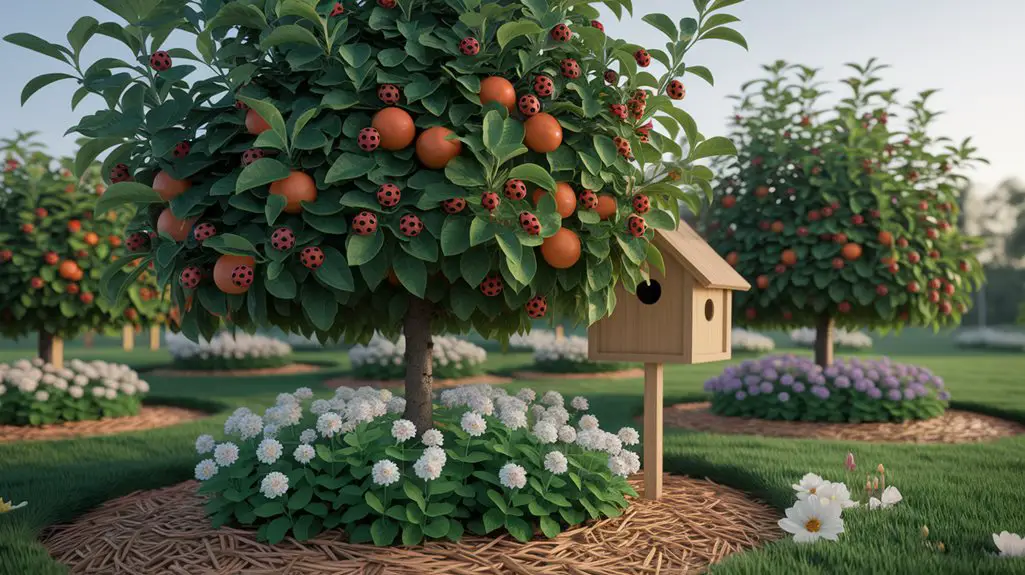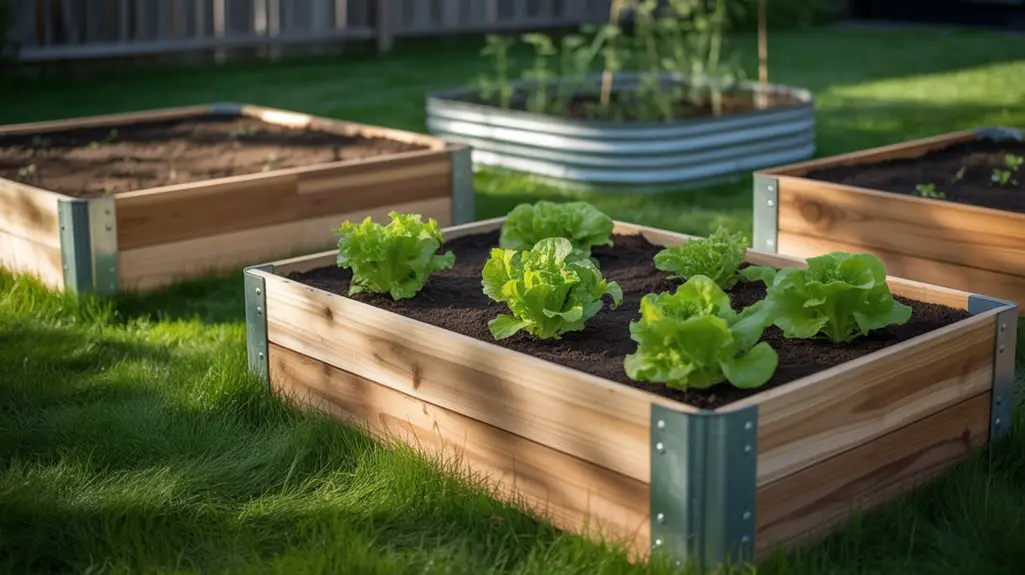When pests descend on your fruit trees like an unwelcome army, you don’t need to reach for chemical weapons. You’re facing a challenge that gardeners have managed for centuries using nature’s own defense systems. Natural pest control methods offer you effective alternatives that protect your harvest while preserving the delicate ecosystem in your garden. By understanding the intricate balance between pests, predators, and your precious fruit trees, you’ll discover how to harness these relationships to your advantage.
Beneficial Insects: Nature’s Pest Management Team
Guardians of the orchard, beneficial insects form the frontline defense in any sustainable pest management strategy.
You’ll want to cultivate populations of ladybugs, lacewings, and parasitic wasps that prey on common fruit tree pests like aphids, scale insects, and caterpillars.
To attract these helpful allies, plant diverse flowering companions such as yarrow, dill, and alyssum near your fruit trees.
These provide nectar and pollen that sustain adult beneficial insects between pest outbreaks.
Consider installing insect hotels—structures with various nesting materials—to offer shelter during dormant seasons.
Avoid broad-spectrum pesticides, even organic ones, which can harm your beneficial insect populations.
Companion Planting Strategies for Fruit Trees

Beyond beneficial insects, thoughtful companion planting creates a vibrant ecosystem around your fruit trees that naturally deters pests while improving overall orchard health.
These strategic plant combinations work synergistically to disrupt pest cycles while enhancing pollination and soil fertility.
Select companion plants based on their specific protective qualities:
- Aromatic herbs like mint, thyme, and lavender repel aphids and other soft-bodied insects through their volatile essential oils.
- Deep-rooted plants such as comfrey and yarrow mine nutrients from subsoil layers, making them available to your fruit trees.
- Flowering natives like echinacea and rudbeckia attract predatory wasps that target codling moths and other fruit tree pests.
- Alliums, including garlic and chives, emit sulfur compounds that deter borers and fungal pathogens.
Incorporating organic pest control methods not only enhances the effectiveness of companion planting but also promotes a sustainable gardening approach.
Organic Sprays and Solutions for Common Tree Pests

While chemical pesticides disrupt the delicate balance of your orchard ecosystem, organic spray solutions offer targeted protection without harmful residues or beneficial insect casualties.
Neem oil serves as your versatile first defense, disrupting insect hormone systems and suffocating eggs. Mix 2 tablespoons with a gallon of water for aphids, mites, and scale insects.
For fungal issues, combine 1 part milk with 9 parts water to combat powdery mildew, especially on apple trees.
Garlic-pepper spray deters borers and fruit flies—blend 4 garlic bulbs and 2 hot peppers with water, strain, and apply weekly.
Against codling moths, hang pheromone traps and supplement with kaolin clay spray, which creates a protective film that confuses and repels these persistent pests without compromising fruit quality.
Physical Barriers and Traps for Pest Prevention
Physical barriers represent your first line of mechanical defense when combating orchard pests, complementing the organic sprays you’ve already incorporated.
These preventative measures create obstacles that deter insects and animals before they damage your fruit trees.
- Tree bands/wraps – Apply sticky barriers around trunks to prevent crawling insects like ants and caterpillars from ascending.
- Fine mesh netting – Drape over branches during fruit development to block birds, moths, and fruit flies while allowing pollinators access during flowering.
- Pheromone traps – Disrupt mating cycles of codling moths and other pest species through species-specific attractants.
- Reflective mulch – Confuses flying insects with light reflection while conserving soil moisture and reducing weed competition.
Implement these solutions as part of your integrated pest management approach for healthier, more productive trees without synthetic chemicals.
Pruning and Maintenance Techniques to Reduce Infestations
Proper pruning stands as one of the most effective cultural practices for maintaining fruit tree health and preventing pest problems before they begin.
When you prune, you’re removing potential pest habitats while improving air circulation, which reduces fungal disease incidence.
Focus on eliminating crossing branches, water sprouts, and dead wood where pests often harbor. Maintain an open center canopy that allows sunlight to penetrate all parts of the tree. This light exposure discourages moisture-loving pests and pathogens.
Time your pruning strategically—late winter for most deciduous fruit trees and immediately after harvest for others.
Remember to sanitize tools between cuts when working with diseased branches to prevent pathogen spread. Collect and dispose of pruned material rather than leaving it near your trees where it could reintroduce pests.
Soil Health Management to Strengthen Tree Defenses
Beneath every thriving fruit tree lies a complex ecosystem that serves as the foundation for natural pest resistance.
When you enhance your soil’s biological activity, you’re effectively strengthening your trees’ natural defense mechanisms against common pests.
- Apply compost annually to introduce beneficial microorganisms that compete with or consume pathogenic organisms.
- Maintain proper pH levels (typically 6.0-6.5 for most fruit trees) to guarantee ideal nutrient availability.
- Use organic mulches like wood chips or straw to regulate soil temperature and retain moisture.
- Incorporate cover crops such as clover or vetch during dormant seasons to add nitrogen and prevent soil erosion.
You’ll notice that trees growing in healthy, biologically active soil develop stronger immune responses and produce natural compounds that deter pests, reducing the need for intervention later in the season.
Natural Fungal and Bacterial Controls for Fruit Trees
While healthy soil provides the foundation for robust fruit trees, addressing fungal and bacterial challenges requires specific organic approaches.
You’ll find copper-based sprays effective against fire blight and bacterial spot, though use them sparingly to prevent soil accumulation.
Neem oil serves as a powerful antifungal for powdery mildew and rust infections when applied biweekly during humid periods.
Consider Bacillus subtilis products for biological control of numerous fungal pathogens. This beneficial bacterium creates a protective shield on leaf surfaces.
For preventative treatment, spray compost tea enriched with beneficial microbes directly onto foliage and branches.
Apple cider vinegar solutions (1 tablespoon per gallon of water) can disrupt fungal spore germination on tree surfaces.
Remember that timing applications before rain events and during dormant seasons greatly increases their effectiveness.
Seasonal Pest Management Timeline for Orchards
Successful organic orchard management depends on understanding the precise timing of both pest emergence and appropriate interventions throughout the growing cycle.
You’ll need to align your efforts with your trees’ developmental stages for maximum effectiveness while minimizing ecosystem disruption.
- Dormant season (winter): Apply dormant oils to smother overwintering eggs and remove mummified fruits harboring disease spores.
- Pre-bloom (early spring): Set pheromone traps for monitoring pest populations and deploy beneficial nematodes for soil-dwelling pests.
- Post-bloom (late spring): Release predatory insects like ladybugs and lacewings as flower petals drop and fruits begin forming.
- Summer maintenance: Implement weekly kaolin clay applications during peak insect pressure periods while maintaining orchard biodiversity.
This cyclical approach respects natural rhythms while creating multiple barriers to prevent pest populations from reaching damaging thresholds. Additionally, incorporating natural pest control tips from surrounding flower gardens can enhance your orchard’s resilience against pests.
Conclusion
You’ll find that embracing natural pest control creates a thriving ecosystem around your fruit trees. By integrating beneficial insects, companion planting, organic solutions, and mindful maintenance, you’re building resilience from soil to canopy. Remember, “The best fertilizer is the gardener’s shadow”—your regular attention and holistic approach not only solves immediate pest problems but regenerates the entire orchard system, working with nature rather than against it.




